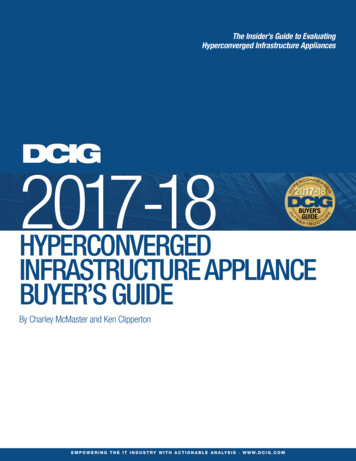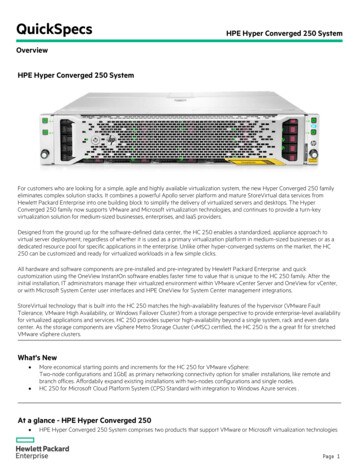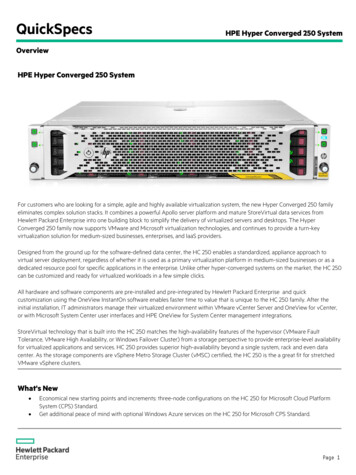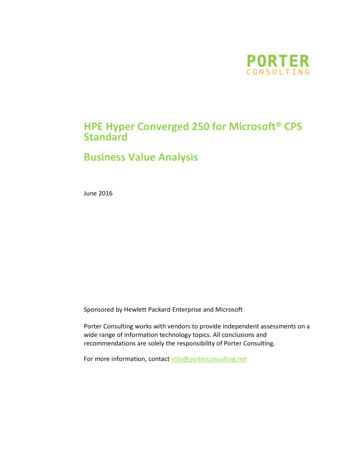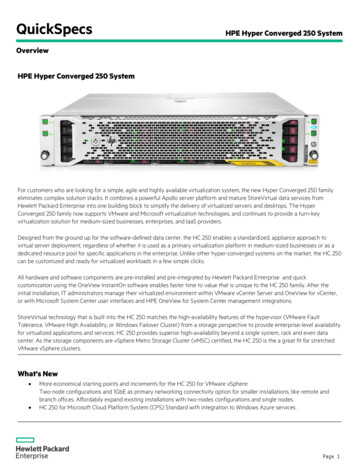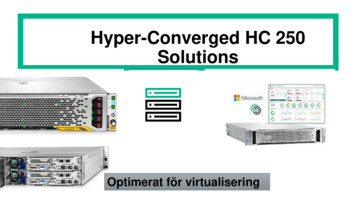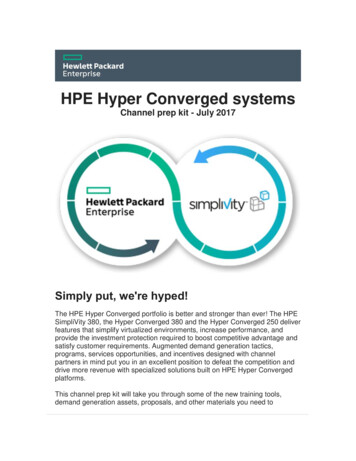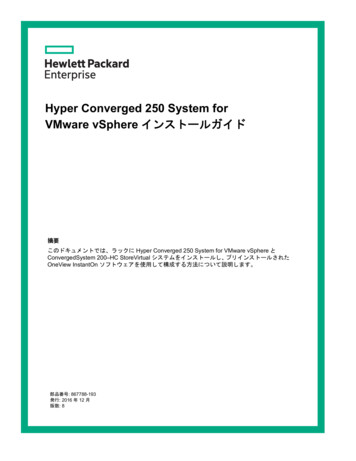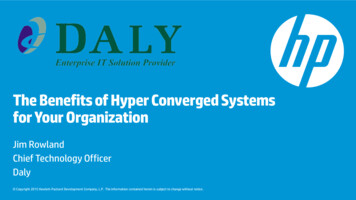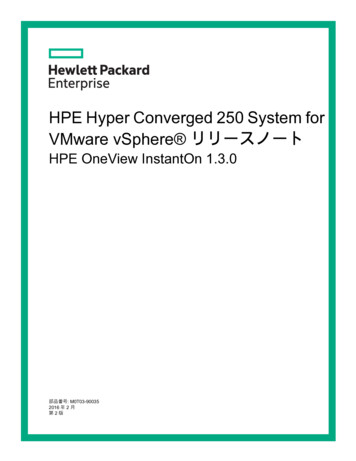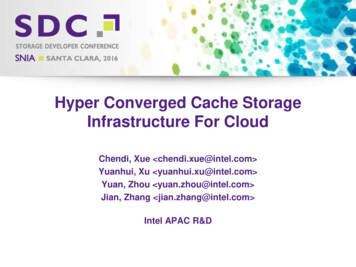
Transcription
Hyper Converged Cache StorageInfrastructure For CloudChendi, Xue chendi.xue@intel.com Yuanhui, Xu yuanhui.xu@intel.com Yuan, Zhou yuan.zhou@intel.com Jian, Zhang jian.zhang@intel.com Intel APAC R&D2016 Storage Developer Conference. 2016 Intel Corp. All Rights Reserved.
Agenda IntroductionHyper Converged StorageHyper Converged Cache Architecture Overview Design details Performance overviewHyper Converged Cache with 3D XPointTM technologySummaryIntel and Intel logos are trademarks of Intel Corporation or its subsidiaries in the U.S. and/or other countries2016 Storage Developer Conference. 2016 Intel Corp. All Rights Reserved.2
Introduction Intel Cloud and Bigdata Engineering TeamDeliver optimized open source cloud and Bigdata solutions on Intel platforms Open source leadership @Spark*, Hadoop*, OpenStack*, Ceph* etc.Working closely with community and end customersBridging advanced research and real-world applications*Other names and brands may be claimed as the property of others.Intel and Intel logos are trademarks of Intel Corporation or its subsidiaries in the U.S. and/or other countries 32016 Storage Developer Conference. 2016 Intel Corp. All Rights Reserved.
Hyper Converged Storage Hyper-converged Infrastructure and Hyper-converged storage “Converged systems are essentially pooled systems comprising thefour essential datacenter components – servers, storage, networks, andmanagement software.” [1] Hyper-converged infrastructure pushes storage change.[1] onvergence-when-converged-systems-grow-up[PICTURE Source] 0-common-vsan-questions/2016 Storage Developer Conference. 2016 Intel Corp. All Rights Reserved.4
Hyper Converged Storage Managing VMs and not storage All storage actions are taken on a per virtual machine basis rather thanhaving to understand LUNs, RAID groups, storage interfaces, etc.[PICTURE Source] able/Intel does not control or audit third-party info or the web sites referenced in this document. You should visit the referenced web site and confirm whether 5referenced data are accurate.2016 Storage Developer Conference. 2016 Intel Corp. All Rights Reserved.
Ceph*: OpenStack* de fecto storage backend[1]Ceph* is an open-source, massively scalable, software-defined storage systemthat provides object, block and file system storage in a single platform. It runson commodity hardware—saving you costs and giving you flexibility—andbecause it’s in the Linux* kernel, it’s easy to consume. Object store (RADOSGW) File system (CEPHFS) A bucket-based REST gatewayCompatible with S3 and swiftA POSIX-compliant distributed file systemKernel client and FUSEBlock device service (RBD) OpenStack* native supportKernel client and QEMU*/KVM driverApplicationRGWA webservicesgateway forobject storageHost/VMRBDA reliable, fullydistributedblock deviceClientCephFSA distributedfile systemwith POSIXsemanticsLIBRADOSA library allowing apps to directly access RADOSRADOSA software-based, reliable, autonomous, distributedobject store comprised of self-healing, selfmanaging, intelligent storage nodes and lightweightmonitors[1] e-de-facto-storage-backend-for-openstack*Other names and brands may be claimed as the property of others.2016 Storage Developer Conference. 2016 Intel Corp. All Rights Reserved.6
Gap on OpenStack* Storage A strong demands for SSD caching in Ceph* clusterCeph* SSD caching performance has gaps Cache tiering, Flashcache/bCache not work wellOpenStack* storage lacks a caching layer*Other names and brands may be claimed as the property of others.2016 Storage Developer Conference. 2016 Intel Corp. All Rights Reserved.7
Hyper Converged Cache: Overview Building a hyper-converged cache solutionsfor the cloud Started with Ceph* Block cache, object cache, file cacheExtensible Framework Pluggable design/cache policies General caching interfaces: Memcachedlike API Support third-party caching softwareAdvanced data services: Compression, deduplication, QOSValue added feature for future SCM devicewritereadMemory tenceCeph*Other names and brands may be claimed as the property of others.2016 Storage Developer Conference. 2016 Intel Corp. All Rights Reserved.8
Hyper Converged Cache: different adaptersApplication Host/VMClientRBD:RBDCephFSRGWA reliable,A distributedA web services Hooks on librbdApplicationfullyfile systemgateway fordistributedwith POSIXobject storage caching for small writesblock devicesemanticsRGW: Caching over http For metadata and small dataCaching LayerCephFS: Extend POSIX API Caching for metadata andLIBRADOSsmall writesA library allowing apps to directly access RADOSRADOSA software-based, reliable, autonomous,distributed object store comprised of selfhealing, self-managing, intelligent storage nodesand lightweight monitors*Other names and brands may be claimed as the property of others.2016 Storage Developer Conference. 2016 Intel Corp. All Rights Reserved.9
Hyper Converged Cache: Design Detailsblock cache details(1)Compute NodeCompute Node VMRBDVMVM VM RBDWrite I/OCachingLayerRead I/OLocal StoreWritecacheReadcache Writecache ReadcacheReplicateCoalesce andasync drainCapacityLayerLocal StoreCacheOSDOSDOSDOSDOSDOSDOSDHyper-converged deploymentAlso, support deduped read cache and persistent write cache for VM scenario.2016 Storage Developer Conference. 2016 Intel Corp. All Rights Reserved.10
Hyper Converged Cache: Design Detailsblock cache details(2)Compute Node Cache ServiceCompute NodeCompute NodeCompute NodeCache ServiceCache ServiceCache ServiceNetworkInterfaceLibCacheServiceLocal StoreWritecacheAIO lush/EvictWorkqueueTransactionRead/Write TransactionFlush/evict TransactionFlush/evictCeph*OSDOSDOSDMempoolMem/PM MetaStoreDataStoreSSDBackendStoreLIBRBD/LIBRADOS/ Transactional read/write supportDifferential service for each RBD*Other names and brands may be claimed as the property of others.2016 Storage Developer Conference. 2016 Intel Corp. All Rights Reserved.11
Hyper Converged Cache: Design Detailsblock cache details(2)Metadata tablemoid1Moid2dkey1Dkey2In-Mem Metadatahash1hash2In-Mem DataindexData Storedkey1dkey2dkey3 4k block4k block4k blockNetworkInterfaceLibCacheServiceAIO reTransactionWrite DataStoreSSDCache ServiceWrite cache is using log appending.On each write request, persistent the data into free slots on SSD, and updatethe metadata tableif it’s in the read cache, will also invalidate that entry2016 Storage Developer Conference. 2016 Intel Corp. All Rights Reserved.12
Hyper Converged Cache: Data StoreWRRBDAppend-only login-memIndex RAM BufferSSD friendly IO patternEvictDaemonGC workwhen tSegment Segment132016 Storage Developer Conference. 2016 Intel Corp. All Rights Reserved.
Hyper Converged Cache: Read CacheMetadata tablemoid1Moid2dkey1Dkey2In-Mem Metadatahash1hash2In-Mem DataindexData Storedkey1dkey2dkey3 NetworkInterfaceLibCacheService4k block4k block4k blockAIO readWorkqueueTransactionreadMempoolMem/PM BRBD/LIBRADOS/ Cache ServiceRead cache is CAS (content-addressable storage) and stores hash/valuecombinations on SSD or flash storage.On each read request, look up hash in the metadata table firstIf miss, then go to look up in the write-cacheGo to Ceph cluster if miss again142016 Storage Developer Conference. 2016 Intel Corp. All Rights Reserved.
Hyper Converged Cache: Flush & EvictLibCacheServiceCache tionFlush/evictMempoolMem/PM MetaStoreDataStoreSSD TransactionFlush/evictBackendStoreLIBRBD/LIBRADOS/ Cache Service will automatically flush the cached contents to Cephcluster as the cache ratio reaches certain value.Based on LRU, the hot data will be kept in cache152016 Storage Developer Conference. 2016 Intel Corp. All Rights Reserved.
Hyper Converged Cache: Failover & Recovery Master/Slave architecture Two hosts are requiredin order to providephysical redundancyThe cache layer will runinto read-only state ifmaster fails All cached writes willbe flushed to Ceph All writes will be writtento Ceph directly Also can cache writesif only single copy ofcache is acceptable.Pacemaker* corosync*to handle systemavailabilityCompute NodeCompute NodeVM VMRBDVM VM RBDWrite I/OCachingLayerRead I/OLocal StoreWritecacheLocal StoreReadcacheWritecache LayerOSDOSDOSDOSDOSDOSDOSD*Other names and brands may be claimed as the property of others. 162016 Storage Developer Conference. 2016 Intel Corp. All Rights Reserved.
Hyper Converged Cache: ce comparison5RBDRBD w/ Cache TierperformanceRBD w/ caching0latency Hyper converged cache is able to provide 7x performance improvements w/zipf 4k randwrite, the latency also decreased 92%. Comparing with cache tier, the performance improved 5x, the code path ismuch simpler.Performance numbers are Intel Internal estimatesFor more complete information about performance and benchmark results, visit www.intel.com/benchmarks2016 Storage Developer Conference. 2016 Intel Corp. All Rights Reserved.17
3D XPoint TechnologySRAMLatency: 1XSize of Data: 1XDRAMLatency: 10XSize of Data: 100XSTORAGE3D XPoint Latency: 100XSize of Data: 1,000XNANDLatency: 100,000XSize of Data: 1,000XHDDLatency: 10 MillionXSize of Data: 10,000 XPerformance numbers are Intel Internal estimatesFor more complete information about performance and benchmark results, visit www.intel.com/benchmarksIntel and Intel logos are trademarks of Intel Corporation or its subsidiaries in the U.S. and/or other countries[1] ls/Proceedings/2016/20160810 K21 Zhang Zhang Zhou.pdfTechnology claims are based on comparisons of latency, density and write cycling metrics amongst memory technologiesrecorded on published specifications of in-market memory products against internal Intel specifications.2016 Storage Developer Conference. 2016 Intel Corp. All Rights Reserved.18
Storage Hierarchy TomorrowDRAM: 10GB/s per channel, 100 nanosecond latencyServer side and/or AFABusiness ProcessingHigh Performance/In-Memory AnalyticsScientificCloud Web/Search/GraphHot3D XPoint DIMMsNVM Express* (NVMe)3D XPoint SSDsBig Data Analytics (Hadoop*)Object Store / Active-ArchiveSwift, lambert, HDFS, Ceph*WarmNVMe 3D NAND SSDs 6GB/s per channel 250 nanosecond latencyPCI Express* (PCIe*) 3.0 x4 link, 3.2 GB/s 10 microsecond latencyPCIe 3.0 x4, x2 link 100 microsecond latencyColdNVMe 3D NAND SSDsSATA or SAS HDDsLow cost archiveSATA* 6GbpsMinutes offlinePerformance numbers are Intel Internal estimatesFor more complete information about performance and benchmark results, visit www.intel.com/benchmarksIntel and Intel logos are trademarks of Intel Corporation or its subsidiaries in the U.S. and/or other countries[1] ls/Proceedings/2016/20160810 K21 Zhang Zhang Zhou.pdfComparisons between memory technologies based on in-market product specifications and internal Intel specifications.2016 Storage Developer Conference. 2016 Intel Corp. All Rights Reserved.19
Intel Optane storage (prototype) vsIntel SSD DC P3700 Series at QD 1Performance numbers are Intel Internal estimatesFor more complete information about performance and benchmark results, visit www.intel.com/benchmarksIntel and Intel logos are trademarks of Intel Corporation or its subsidiaries in the U.S. and/or other countries[1] ls/Proceedings/2016/20160810 K21 Zhang Zhang Zhou.pdfTests document performance of components on a particular test, in specific systems. Differences in hardware, software, or configuration will affect actualperformance. Consult other sources of information to evaluate performance as you consider your purchase. For more complete information about performance andbenchmark results, visit http://www.intel.com/performance. Server Configuration: 2x Intel Xeon E5 2690 v3 NVM Express* (NVMe) NAND based SSD: Intel20P3700 800 GB, 3D Xpoint based SSD: Optane NVMe OS: Red Hat* 7.12016 Storage Developer Conference. 2016 Intel Corp. All Rights Reserved.
Intel Optane shows significantperformance improvement over PCIe SSDfor RocksDB* Key/Value cloud benchmark*[1]2X theThroughputPCIe SSD5X lower 99th%Intel OptaneHigher is betterPCIe SSDIntel OptaneLower is betterPerformance numbers are Intel Internal estimatesFor more complete information about performance and benchmark results, visit www.intel.com/benchmarksIntel and Intel logos are trademarks of Intel Corporation or its subsidiaries in the U.S. and/or other countries[1] ls/Proceedings/2016/20160810 K21 Zhang Zhang Zhou.pdf*Benchmarked on early prototype samples, 2S Haswell/Broadwell Xeon platform single server. Data produced without any tuning. We expect performance toimprove with tuning.*Other names and brands may be claimed as the property of others.2016 Storage Developer Conference. 2016 Intel Corp. All Rights Reserved.21
Hyper Converged Cache with 3D XPointTMtechnologyVMLayer3Compute NodeCompute NodeVMVM VMVMVM cacheRBDcacheRBDHypervisorLayerLocal StoreWritecache2ReadcachePageCacheStorageServer WritecacheBlock BufferPageCacheReadcacheBlock BufferIndependent Cache LayerOSD1Local DPageCacheBlockBufferOSDPageCacheBlockBufferUsing Intel Optane device as block buffer cache device.Using Intel Optane device as page caching device.Using 3D XPointTM device as OS L2 memory?Intel and Intel logos are trademarks of Intel Corporation or its subsidiaries in the U.S. and/or other countries 222016 Storage Developer Conference. 2016 Intel Corp. All Rights Reserved.
SummaryHyper Converged Cache provides 6xperformance improvements, w/ 92% latencyreduce. With the emerging new media like 3D-XPointTM,the caching benefit will be more higher Next step: Tests on objects and filesystem Performance numbers are Intel Internal estimatesFor more complete information about performance and benchmark results, visit www.intel.com/benchmarksIntel and Intel logos are trademarks of Intel Corporation or its subsidiaries in the U.S. and/or other countries 232016 Storage Developer Conference. 2016 Intel Corp. All Rights Reserved.
Backup242016 Storage Developer Conference. 2016 Intel Corp. All Rights Reserved.
H/W ConfigurationClient ClusterCPUClient1MON10GbNICOSD18 x 1TB HDD2x 400GB DC S3700cache1x DC370010GbNICOSD28 x 1TB HDD2x 400GB DC S3700Memory96 GBNIC10GbDisks 1 HDD for OS400G SSD for cacheCeph ClusterCPUOSD: Intel(R) Xeon(R) CPUE31280 @ 3.50GHzMemory32 GBNIC10GbEDisks Intel(R) Xeon(R) CPU E52680 v3 @ 2.80GHz2 x 400 GB SSD (Journal)8 x 1TB HDD (Storage)2 hosts Ceph cluster each host has 8 x 1TB HDD as OSDs and 2x Intel DCS3700 SSD journal1 Client with 1x 400GB Intel DC S3700 SSD as cache device252016 Storage Developer Conference. 2016 Intel Corp. All Rights Reserved.
S/W Configuration Ceph* version : 10.2.2 (Jewel)Replica size : 2 Data pool : 16 OSDs. 2 SSDs for journal, 8 OSDs on eachnode OSD Size : 1TB * 8 Journal Size : 40G * 8 Cache: 1 x 400G Intel DC S3700 FIO volume size: 10GCetune test benchmark fio librbdCetune: https://github.com/01org/cetune*Other names and brands may be claimed as the property of others.2016 Storage Developer Conference. 2016 Intel Corp. All Rights Reserved.26
Testing Configuration Test cases: Operation: 4K random write with fio(zipf 1.2)Detail case: Cache size volume size (w/ zipf) w/o flush & evict: cache size 10G. w/ flush w/o evict: cache size 10G. w/ flush & evict: cache size 10G. Hot data volume size * zipf1.2(5%),runtime 4 hoursCaching Parameters: object size 4096 cache flush queue depth 256 cache ratio max 0.7 cache ratio health 0.5cache dirty ratio min 0.1cache dirty ratio max 0.95cache flush interval 3cache evict interval 5Runtime: Base: 200s ramp up,14400s runDataStoreDev /dev/sdecache total size 10Gcacheservice threads num 128agent threads num 32272016 Storage Developer Conference. 2016 Intel Corp. All Rights Reserved.
Legal Notices and DisclaimersNo license (express or implied, by estoppel or otherwise) to any intellectual property rights is granted by this document.The products and services described may contain defects or errors known as errata which may cause deviations from publishedspecifications. Current characterized errata are available on request.Intel technologies’ features and benefits depend on system configuration and may require enabled hardware, software or serviceactivation. Performance varies depending on system configuration. No computer system can be absolutely secure. Check withyour system manufacturer or retailer or learn more at [intel.com].Tests document performance of components on a particular test, in specific systems. Differences in hardware, software, orconfiguration will affect actual performance. Consult other sources of information to evaluate performance as you consider yourpurchase. For more complete information about performance and benchmark results, visit http://www.intel.com/performance.Cost reduction scenarios described are intended as examples of how a given Intel-based product, in the specified circumstancesand configurations, may affect future costs and provide cost savings. Circumstances will vary. Intel does not guarantee any costsor cost reduction.This document contains information on products, services and/or processes in development. All information provided here issubject to change without notice. Contact your Intel representative to obtain the latest forecast, schedule, specifications androadmaps.Statements in this document that refer to Intel’s plans and expectations for the quarter, the year, and the future, are forwardlooking statements that involve a number of risks and uncertainties. A detailed discussion of the factors that could affect Intel’sresults and plans is included in Intel’s SEC filings, including the annual report on Form 10-K.Intel does not control or audit third-party benchmark data or the web sites referenced in this document. You should visit thereferenced web site and confirm whether referenced data are accurate.Software and workloads used in performance tests may have been optimized for performance only on Intel microprocessors.Performance tests, such as SYSmark and MobileMark, are measured using specific computer systems, components, software,operations and functions. Any change to any of those factors may cause the results to vary. You should consult other informationand performance tests to assist you in fully evaluating your contemplated purchases, including the performance of that productwhen combined with other products.Intel, the Intel logo, Xeon, 3D-XPointTM are trademarks of Intel Corporation in the U.S. and/or other countries.*Other names and brands may be claimed as the property of others.282016 Storage Developer Conference. 2016 Intel Corp. All Rights Reserved.
Hyper converged cache is able to provide 7x performance improvements w/ zipf 4k randwrite, the latency also decreased 92%. Comparing with cache tier, the performance improved 5x, the code path is . 250 nanosecond latency PCI Express * (PCIe

